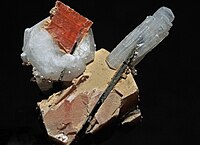
Photo from wikipedia
Elongate mineral particles, including asbestos, have long been screened in talc and other mineral powders. In recent years, there has been a renewed scrutiny of talc containing asbestos due to… Click to show full abstract
Elongate mineral particles, including asbestos, have long been screened in talc and other mineral powders. In recent years, there has been a renewed scrutiny of talc containing asbestos due to allegations in civil litigation in the United States as well as reports, proposals, and white papers by international laboratories and government bodies related to this subject. This study demonstrates the importance of the fundamental understanding of both mineralogy and its application, using microscopy with empirical examples from conflicting analyses of the same talc powders by two independent laboratories in civil litigation in the United States. Methods include polarized light microscopy (PLM), scanning electron microscopy (SEM), and transmission electron microscopy (TEM) in the accurate measurement of morphological, optical, compositional, and structural data to characterize mineral-based samples. Discussions in this study include: 1) contrasting the interlaboratory findings of amphibole and amphibole asbestos by PLM and TEM using various preparation techniques, 2) the use of multiple analytical tools on a singular particle for identification, 3) the misidentification of anthophyllite asbestos by inexpert use of electron diffraction using TEM, and 4) the misidentification of chrysotile in talc by PLM. These examples emphasize the importance of not only maintaining the existing requirements, but of the need for even more rigorous analytical requirements in routine monitoring of elongate mineral particles that may occur in mineral-based powders.
Journal Title: Environmental research
Year Published: 2022
Link to full text (if available)
Share on Social Media: Sign Up to like & get
recommendations!